I have always spoken publicly about my use of heat on my natural hair. It is something I have chosen to do to manage my natural hair due to my lifestyle and my personal taste. Using heat has helped me to maintain healthy hair, retain length, and reach several hair length goals. In this post I hope to share with you my experience, my methods, and hopefully those of you who have been searching high and low for this information will get the info you need to make your own personal decision when it comes to using heat.
- Why do I use heat in my regimen?
I personally like how easy my hair is to manage when I use heat. My knots and tangles are very minimal and I experience less breakage and shedding throughout the week. I have really tight 4a curls mixed with 4b and 4c hair. My hair shrinks up to over half of it’s actual length. It tangles so much, it makes it difficult to maintain health and length. So, my goal is not to have straight hair, but to manipulate my hair in a way that helps me to maintain it easily daily. During the time that I started using heat I retained more length than ever in my journey. I started a growth journey on Youtube in my second year starting at about shoulder or armpit length and in about two years on my four year anniversary reaching waist length.
❤ My Journey To Waist Length ❤
- When did I first use heat?
I started using heat on my natural hair when I turned 2 years natural. It was the day of my second year anniversary and I did my first blow out since being natural.
I used a flat iron on my natural hair for the first time on my four year anniversary.
- Why did I wait so long?
I waited because I was still learning about my natural hair. When I first went natural I didn’t even know I was going natural. I had no confidence in my natural hair and my ability to maintain it. So, after my first year I found Youtube and blogs. There was so much information out there, I continued to take in every single thing. I have literally gone through so many phases in my natural hair journey due to information I thought was “fact”. As I progressed in my journey I continued to educate myself, but I learned to only take what I needed and leave the rest behind. This was one of the best things I could have ever done in my journey, because I developed my “keep it simple philosophy” when it came to my hair. Anyways, I got rid of the fear of heat damage, and burning off my hair. I finally decided to jump in, enjoy my journey, and do the things that worked for “my” hair.
- How often do I use heat?
When I first started using heat, I was only comfortable with once a month. This later changed into twice a month (every two weeks), and now I use once a week. I would NEVER use more than once a week.
- What tools do I use?I started using blow dryers regularly, but later found it less stressful on my hair to use a flat iron. I know what you are thinking flat iron less stressful than blow dryer what? The blow dryer for me completely dries my hair out sometimes, but I noticed the flat iron kept some of that moisture in. So let’s start off with how I used my blow dryer and what I used.
*Heat Stretching With Blow Dryer: I used the tension method to blow dry my hair. This made it easier to stretch the hair without over manipulating the hair and running a brush or comb through my hair over and over again. I used the blow dryer on high air with low heat. When the blow dryer is on high air it makes the low heat a little warmer, so it doesn’t take forever to dry.
❤ Tension Blow Drying ❤
*Heat Stretching With Flat Iron: I use the “Andis Ceramic Multi Heat Flat Iron”. The highest temperature on this flat iron is 375 degrees Fahrenheit. The temperature is labeled in numbers 1-20. 20 being the highest heat. I use the flat iron only on level 10. If 20 is the highest heat, that means it would be close to around 375 degrees Fahrenheit. I would assume level 10 which is half of 20 would be half of 375 giving me about 187.5 degrees or a little more. Although we do know that temperatures no matter what the box says varies when it comes to flat irons, so you have to use your own discretion. The reason the temperature is so important is because healthy hair burns at 450 degrees. I personally don’t want to be anywhere near that. Also, I feel comfortable knowing that I am still pretty close to the average temperature of a blow dryer which is about 100-150 degrees. Now, these are things that make me comfortable this could be different for everyone. I only use my flat iron on clean, dry hair. Before I use heat I always do a thorough deep conditioning and sometimes a light protein treatment. Heat takes moisture out of the hair, so deep conditioning adds a little bit more moisture without completely drying the hair out during heat usage. When I flat iron the sections I go over each section ONCE. I also don’t hold the flat iron in place, I go down the strand gently, but as fast as possible to get the results I am looking for. Again, my goal is not “bone straight hair”. I am literally just heat stretching.
- What is heat stretching? I started to refer to my heat usage as heat stretching because number one I didn’t want my use of heat regularly to be mistaken for heat training. I am in no way trying to change the natural texture of my hair. I love my curls and coils, and I love that my hair still has versatility after over three years of regular heat usage. Heat training is when you are intentionally adding an excessive amount of heat to your hair to change the texture of your hair and in the end making it easier to manage. With heat stretching you are not using excessive heat. You stick to low temperatures in order to maintain the structure and health of your hair as much as possible. Your only goal is to literally just stretch your hair pretty much like twisting, bunning, African threading, wrapping, braiding, just to name a few. I have chosen to use this method over the others, due to better results and success.
- My Tips For Preventing Heat Damage
* I changed the way that I looked at using the flat iron in comparison to my relaxed days. As someone who has natural hair, I know my hair and understand that it frizzes at the drop of a dime. Going for bone straight hair is useless, and unrealistic for “me”. This is why I just focus on stretching and not necessarily straightening. When you are trying to straighten natural hair and get that bone straight look, you feel compelled to use high heat to achieve those results, and it leads to unhealthy practices for some.
* Moisture is key. Deep conditioning your hair before and after heat usage could be one of the best things that you do for your hair. Always keep in mind that heat takes the moisture from your hair, so adding to it can only help. Also, I find that going for long periods trying to maintain straight hair leads to dryness and breakage. This is why I have chosen to wash weekly and heat stretch weekly. I need to keep my hair clean and moisturized regularly. This gives me a week of nicely stretched hair. It also keeps me from going long periods of time without water in my hair, which I find to be very dangerous for my hair.
* Low Manipulation Is Your Friend. When I heat stretch I usually go for a low manipulation hairstyle. Buns are my go to hairstyle, and this keeps me from over manipulating my hair throughout the week. It also makes it easier to keep the hair stretched. When I heat stretch my hair the goal is always to make it easier to manage and maintain my hair. So, excessive styling would defeat the purpose and could do more harm than good especially when paired with heat.
- How do I maintain my heat stretched hair with fitness, weather, etc.? Again I will mention realistic expectations. Frizz, shrinkage, etc. is a part of the journey. I have not found any method that completely prevents these things. To minimize frizz I always focus on how I prepare my hair. One thing that I know causes frizz is dryness. I always deep condition my hair thoroughly before using heat. I am big on oils so I love to add oils to my hair to not only add shine, but help “minimize” frizz. I live in a climate that has high humidity, so I understand that if there is a lot of moisture in the air, my hair will revert. There is no way to stop this process. Our hair is made up of bonds. One of the bonds that makes our hair so awesome are the hydrogen bonds. These bonds allow our hair to be shifted into so many amazing shapes, curls, etc temporarily. When moisture is introduced into the hair it changes the bonds, once it dries it stays in whatever shape you have placed it in. Once water is re introduced into the hair it causes the bonds to be broken and in the end revert. This is why humidity is NOT our friend when we have an amazing twist out. LOL! When we are having a high humidity day, the truth is I go for a bun. This keeps my hidden so that I can keep it stretched longer.
- Heat Protectant: I have tried a couple of different heat protectants in the past, but for about two years I have been using extra virgin olive oil. I started to use this oil as a heat protectant, because I didn’t really like the way heat protectants made my hair feel. After careful research I decided to start using the oil, it was already a regular part of my hair regimen, so it was not a hassle. Extra virgin olive oil as a high smoke point meaning it can tolerate high heat. You still want to be careful with this, because that all depends on how high the heat is you are using. Extra virgin olive oil’s smoke point is 375 – 405 degrees Fahrenheit, 191 – 207 degrees Celsius. Even though this is the smoke point, you don’t want to use heat that is extremely hot, because that could make the oil ineffective. In my opinion this goes for any type of heat protectant. Always go as low as possible when using heat, that is my personal rule.
*A Few Other Oils You Can Use As A Heat Protectant
-Grapeseed Oil
-Argan Oil
-Coconut Oil
-Avocado Oil
-Sunflower Oil
- When Not To Use Heat: All of the information that I have provided above is ONLY when dealing with HEALTHY hair. You do not want to add heat to damaged, brittle, dry, breaking hair. Adding heat will destroy the hair even more only increasing your hair problems. So just make note to always pay attention to your hair, how it is behaving so that you can a make a good decision on whether you should or should not be using any heat. The truth is sometimes our hair just needs a break from some of the things we put it through during the year including heat, certain styling routines, etc. Examine Your Regimen to find what could be affecting your hair and when it is healthy you can make a decision on how much heat if any to use.
- Quick Notes – How hot is too hot?!?! Just make a note that HEALTHY hair burns at 450 degrees Fahrenheit. Fine hair can burn around the 200s – 300s. So, make sure you are familiar with the type of hair you have. I just always have a rule for my hair and I never go near 400. I will barely touch 300. Again, the lower you can go and achieve the results you like the better.
Closing
This article is in no way to encourage others to add heat styling to their regimen. This is for those who are currently using heat or may be considering. This is based off of my personal experience and research. In the end using heat is a big decision when it comes to hair maintenance. You have to always be very careful and understand the risk that comes with doing it, even just once. DO YOUR RESEARCH! I truly hope this helps someone!
If you would like to discuss this more in detail or if you have any other questions regarding natural hair. Click The link below! I look forward to speaking with you!  ————————————————————————-
————————————————————————-
EasyNaturalHair.com
“easy natural hair”
Click MsAliciaJames.com For More “Natural Hair” videos!



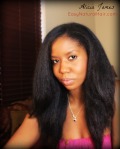
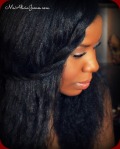
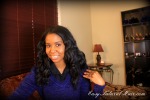
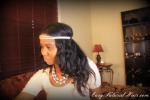
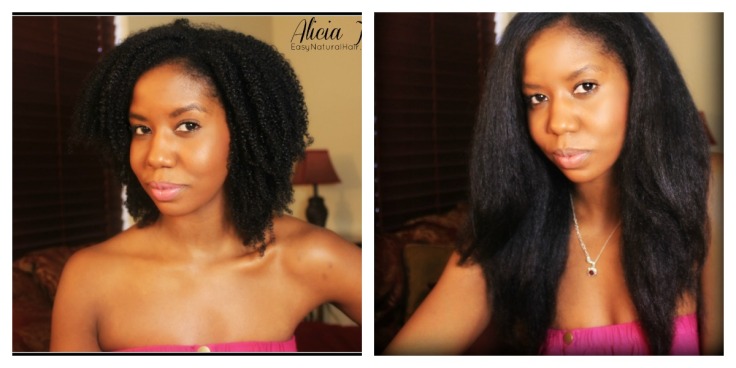
Alicia, I thank you so much for this blog post. I have seriously been considering heat stretching my hair lately. I remember asking a ton of questions regarding this on one of your recent videos (*YT u/n is Jhan) because I have seen that your hair still thrives although you are adding heat. I would like to think that texture/curl-wise, my hair is just like yours (not taking into consideration moisture level, density, etc). So, I have been struggling with tangles, knots, and crazy shedding. I blow-dried my hair for Thanksgiving and loved the results so much. I also loved the ease… and honestly, how the stretched hair actually brightened the look of my face. I wanted to start heat stretching my hair, but didn’t know how to go about it or how often I could do it. This post helps a lot! Thank you!
a great blow dryer out there is the karmin g3 salon pro, check it out!
Thanks for sharing Alicia! GREAT post, I will definitely share this with my mom because she is talking about getting a relaxer and I think heat stretching is a much safer option! You broke it down very nicely, I think this may change my mom’s mind! I LOVE watching your hair journey so inspiring and motivating! I’m at APL right and I’m almost 22 months into my journey (yahoo!), I can’t wait to reach WL it will be a dream come true and I got a long back so I know there’s some serious waiting involved!
Great post Alicia, thanks so much for sharing
I don’t think 10 on your flat iron is half of 375, because that would mean 1 on your flat iron would be 0. Most digital flat irons go down 10 degrees at a time, so 10 is probably 275. That’s just my guess.
This was sooooo on time for me!! So. On.Time. My 4abc high shrinkage hair has reached MBL at its’ longest point thus producing great frustration with regard to detangling time, plus I was rather fatigued with looking somewhat childlike with my so-called braid stretched two-strand twist. I started searching for easy styling options that I personally found professional and attractive and remembered how much I dig your style. Like you, I love my kinks, curls, and coils, yet after much consideration, I’ve made the informed decision that low heat stretching may prove to be beneficial when all lifestyle and preference variables are factored into the equation. So Ms. James, I am extending a general thank you for consistently providing a bevy of helpful information, particularly this post, as we know any use of heat, and certainly heat-stretching, is often considered taboo when discussing natural hair. Keep up the great work! You are truly a beautiful woman both outside and inside! Thanks again =)
This is so helpful to me. I have been researching and I needed some concise information. Thanks 🙂
Great article. Thank you for sharing your knowledge. I have attempted heat stretching because my BSL 4b/mostly 4c hair coils up so much that this is the only method that works for me. I decided to go once a month, then progressed to twice a month. After reading this, i am considering once a week as well, because I also experience a lot of dryness and breakage trying to maintain my stretched hair for longer than a week. There is so much information out there and people say different things but i’m learning to listen to my hair now. I follow you on youtube and learn so much. Watching your journey gives me hope for healthy hair too.
I dont think its good to use heat if you do then your hair is not natural because you are using heat to alter it
Natural means without chemicals not without heat. Twists and braids alter your hair pattern temporarily…but the state of your hair is still “natural”. If you choose to be a heat-less natural or a straight haired natural, tis each his own, however it would benefit you more to be precise in your facts. Love.
Very Nice Alicia. I am gonna try it. I have tried banding, twist, and braids to stretch my hair, but not much heat. I have tried the blowdryer. As you mention, it does sucks up the moisture. I use my electric straighten comb on low heat to stretch out my hair to install box braids. I really like the results for that. Again, thanks so much for your helpful tips. I enjoy all your videos and posts.
Hi, I think your blog might be having browser compatibility issues.
When I look at your blog in Safari, it llooks fine but when opening in Internet Explorer, it
has some overlapping. I just wanted to give you a quick
heads up! Other then that, awesoime blog!
This is super helpful. I’m nearly a year into my journey, but I’ve been keeping my hair in sew-ins because it works better in my corporate office (sorry, but I do have to consider the mindset of my co-workers and clients in this setting). Now that I’m pregnant, my skin has been super sensitive, so I cannot keep it up, but I haven’t really known what to do after I take it down tonight. At least I have some ideas of something to try to find that balance between natural and “corporate professional.” Thank you!
Thanks for sharing this! I never knew coconut, argan, and olive oil could be used as heat protectants. I’ve been fully natural for 3 months, but I stopped relaxing my hair a year and six months ago. I’m still very hesitant about using heat to stretch my hair, but you gave a lot of great information to keep it safe. Your hair is gorgeous!
http://www.tressesandtreats.com
Howdy this is kind of of off topic but I was wanting to know if blogs
use WYSIWYG editors or if you have to manually code with HTML.
I’m starting a blog soon but have no coding know-how so I wanted to get guidance from someone with experience.
Any help would be greatly appreciated!
I enjoy, cause I found just what I used to be having a look for.
You have ended my 4 day long hunt! God Bless you man. Have a great day.
Bye
I used two tips, Olive oil and middle heat.
The results are phenomenal!
It’s great information
Thanks
Great article. I recently had my hair blow dried then flat ironed by a stylist to get it styled and trimmed and noticed that, despite the frizz caused by humidity, my hair didn’t shed nearly as much as when I was detangling my hair after shampooing.
Thanks for this! I so identify with your journey. I went through every phase before realizing I had to keep what was best and discard everything else. The only thing I question is oil being a heat protectant. Just because something has a high smoking point does not mean it reduces the amount of heat transferred to your hair (as silicons do, which is why they have been shown to be the best heat protectants). I have decided to incorporate heat back in because I find the amount of tangles and matting my hair does to lead to mechanical damage from detangling. I tried finger detangling and it was just too much. A realistic and low stress routine is more important, to me, than anything else. I’m going to try the tension method vs comb blow dry. I also got a flat iron with actual temps (not 1-20) and keep it below 250 (ladies try Marshalls or tj maxx for professional flat irons at a reasonable price!). Anywho keep up the positive spirit and good work!
Yes! Finally someone writes about insurance massage.